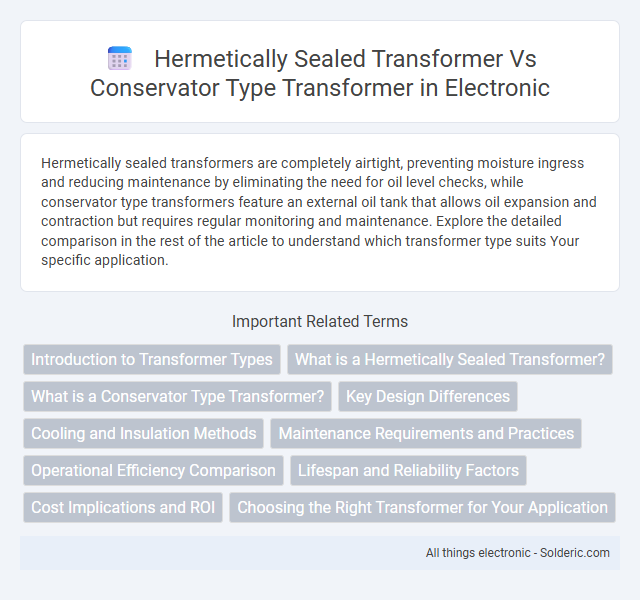Hermetically sealed transformers are completely airtight, preventing moisture ingress and reducing maintenance by eliminating the need for oil level checks, while conservator type transformers feature an external oil tank that allows oil expansion and contraction but requires regular monitoring and maintenance. Explore the detailed comparison in the rest of the article to understand which transformer type suits Your specific application.
Comparison Table
| Feature | Hermetically Sealed Transformer | Conservator Type Transformer |
|---|---|---|
| Design | Fully sealed tank with no external air exposure | Tank connected to external conservator tank |
| Oil Preservation | Oil isolated from atmosphere, preventing contamination | Oil exposed to atmosphere via conservator breather |
| Maintenance | Low maintenance, no oil replacement needed | Requires periodic oil inspection and conservator maintenance |
| Pressure Handling | Designed to withstand internal pressure variations | Pressure relieved via conservator, reducing tank stress |
| Applications | Used in harsh or sealed environments, e.g., submarines | Commonly used in outdoor power distribution |
| Cost | Higher initial cost due to complex sealing | Generally lower cost, simpler design |
Introduction to Transformer Types
Hermetically sealed transformers feature a completely sealed tank to prevent moisture ingress and oxidation, enhancing durability and maintenance-free operation. Conservator type transformers include an external oil reservoir allowing for oil expansion and contraction, which aids in temperature regulation and oil preservation. Your choice depends on site conditions and maintenance preferences, as hermetically sealed models offer compactness and reliability, while conservator types provide better thermal management in varying climates.
What is a Hermetically Sealed Transformer?
A hermetically sealed transformer is designed with a fully sealed enclosure that prevents moisture, air, and contaminants from entering, ensuring enhanced insulation and longer lifespan. Unlike conservator type transformers with expansion tanks that allow air exchange, hermetically sealed transformers use expansion chambers filled with nitrogen or silicone oil to maintain internal pressure. This sealed design reduces maintenance requirements and improves reliability in harsh or sensitive environments.
What is a Conservator Type Transformer?
A conservator type transformer features an oil tank with a separate, air-filled conservator tank connected via a pipe, allowing oil expansion and contraction due to temperature changes. This design maintains optimal oil levels and prevents oxidation, improving transformer longevity and performance. Your equipment benefits from reduced maintenance and enhanced protection compared to hermetically sealed transformers, which have a sealed system without an external oil reservoir.
Key Design Differences
Hermetically sealed transformers feature a completely sealed tank filled with oil or another insulating fluid, preventing moisture ingress and minimizing maintenance. Conservator type transformers include an external oil reservoir connected via a pipe, allowing oil expansion and contraction while maintaining pressure balance. The key design difference lies in the sealed enclosure of hermetically sealed transformers versus the open conservator tank system in conservator transformers, affecting their operational environment and maintenance requirements.
Cooling and Insulation Methods
Hermetically sealed transformers use sealed enclosures filled with insulating oil and nitrogen gas, preventing moisture ingress and ensuring consistent insulation and cooling by natural oil circulation. Conservator type transformers feature an oil conservator tank that accommodates oil expansion and contraction, enabling efficient cooling through oil circulation and cooling radiators while allowing external air exposure. Your choice depends on the environmental conditions and maintenance preferences related to cooling efficiency and insulation protection.
Maintenance Requirements and Practices
Hermetically sealed transformers require minimal maintenance due to their airtight construction, preventing moisture ingress and reducing the need for regular oil checks or top-ups. Conservator type transformers necessitate frequent monitoring of oil levels and periodic maintenance of the conservator tank, including inspection of the breather to avoid moisture contamination. You should consider ease of maintenance and operational environment when choosing between these transformer types.
Operational Efficiency Comparison
Hermetically sealed transformers offer higher operational efficiency due to minimal oil oxidation and reduced maintenance needs, ensuring consistent insulation performance. Conservator type transformers may experience efficiency losses from oil contamination and moisture ingress over time, requiring regular maintenance to maintain optimal function. Your choice should consider the balance between efficiency gains and maintenance commitments in your specific application.
Lifespan and Reliability Factors
Hermetically sealed transformers offer enhanced lifespan and reliability by preventing moisture ingress and oxidation, which reduces insulation degradation over time. Conservator type transformers rely on an oil reservoir with a breather system, making them more susceptible to contamination and requiring regular maintenance to ensure longevity. Your choice between these transformer types should consider the operational environment and maintenance capabilities to optimize performance and durability.
Cost Implications and ROI
Hermetically sealed transformers typically have higher initial costs due to their sealed design and advanced sealing materials, but they offer lower maintenance expenses and longer service life, resulting in improved ROI over time. Conservator type transformers generally incur lower upfront costs but require regular oil level checks, additional maintenance, and potential oil reclamation, which can increase operational expenses and reduce overall ROI. Investing in hermetically sealed transformers is often cost-effective for applications prioritizing reliability and reduced downtime, while conservator types may suit budgets with less emphasis on long-term efficiency.
Choosing the Right Transformer for Your Application
Hermetically sealed transformers offer superior protection against moisture and dust, making them ideal for harsh or outdoor environments where contamination and corrosion risks are high. Conservator type transformers provide enhanced cooling efficiency and easy oil level monitoring, suited for large power applications requiring efficient heat dissipation and maintenance access. Selecting between hermetically sealed and conservator types depends on application-specific factors such as environmental conditions, cooling requirements, and maintenance preferences to ensure optimal performance and longevity.
hermetically sealed transformer vs conservator type transformer Infographic

 solderic.com
solderic.com